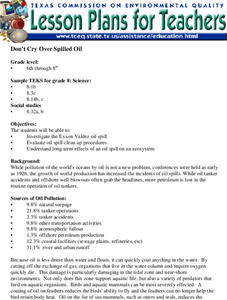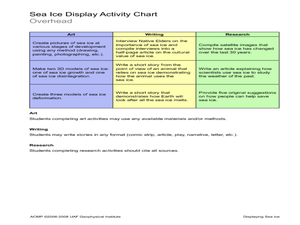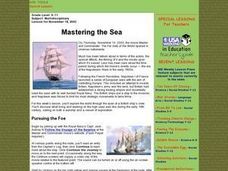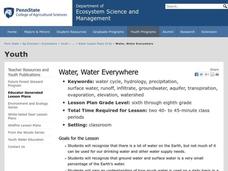Curated OER
Tracking Narwhals in Greenland The Ocean Unicorn
Young scholars study the ecology, habitats, geographic range and feeding habits of narwhals. They determine at least three reasons for the decline in the narwhal populations and complete the accompanying worksheets.
Curated OER
Frozen Out
Students investigate how climate changes affect top predators in Arctic marine ecosystems. Students complete a worksheet and write a report based on their responses to a scientific paper.
Curated OER
Earthquake Epicenter
Learners use chart data to determine the location of the epicenter of an earthquake. This task assesses students' abilities to generalize and infer, organize data, interpret data, and apply mathematical concepts.
Curated OER
Is the Hudson River Too Salty to Drink?
Students explore reasons for varied salinity in bodies of water. In this geographical inquiry lesson plan, students use a variety of visual and written information including maps, data tables, and graphs, to form a hypothesis as to why...
Curated OER
Sea Ice Board Game
Students understand the sea ice cycle and can explain its stages. In this Sea Ice lesson, students play a game to identify types of sea ice. Students answer critical thinking questions about sea ice. Students complete a sea ice worksheet.
Curated OER
Imagine a Kelp Forest
Students write a story based on their research of the kelp forest. In this ecosystem instructional activity, students view a video and research the kelp forest ecosystem. They write a short story imagining the discovery of a new species...
Curated OER
Don't Cry Over Spilled Oil
Students study the Exxon Valdez Oil Spill while evaluating oil spill clean up activities. They discover the long term impact can have on an ecosystem by completing this experiment.
Curated OER
Statue of Liberty
Students discuss aspects of the Statue of Liberty and create their own personalized statue. Students use symbols to represent themselves in their own drawings of the Statue of Liberty.
Curated OER
Build Your Own Sea Turtle
Students design and create their own sea turtles. They investigate the marine turtle anatomy by constructing a model of a sea turtle. They incorporate the vocabulary that identifies each part of the sea turtle's anatomy.
Curated OER
Helping Right Whales - Right Now
In this whales worksheet, pupils answer eight questions referring to the right whales found in the Atlantic Ocean. Students read a map to answer three questions and five questions are multiple choice.
Alabama Learning Exchange
Forces that Change the Land
Students conduct Internet research find information about the following landforms: mountains, canyons, and valleys. They create travel brochures of their findings.
Curated OER
Wanted: Water!
Students determine what percentage of the Earth is water and how much water is needed by humans.
Curated OER
Diverse Environments
Students explore life forms in different environments. After exploring different biomes within their state, students research different plant and animal species within each biome. They prepare a group report on one feature of the region...
Power to Learn
How Much Space Do We Have?
Census-takers view the Internet to find the total population of a city and its total land area. They work with different mathematical scenarios that involve populations and land area in their city. They complete math problems and unit...
Curated OER
Displaying Sea Ice
Students display their knowledge of sea ice. In this earth science activity, students create displays reflecting their understanding of sea ice.Students research the development of sea ice on a variety of bodies...
Curated OER
Floods: Rising Waters and You
High schoolers examine the relationship between human-made structures, flood waters and the increasing population through video clips, websites and a lab experiment.
Curated OER
Mastering the Sea
Students investigate what life was like on early 19th century ships. They participate in a Webquest, explore the website for the movie, 'Master and Commander,' watch movie excerpts, take an interactive tour of a ship, and answer...
Curated OER
Comparing Two Turtles
Young scholars compare and contrast the various observable features of two different turtles. in groups, they complete a visual analysis of the sea turtle and tortoise. Using their observations, they complete Venn Diagram of the...
Curated OER
Water, Water Everywhere
Students recognize that all of the water on earth cannot be used for drinking and that the percentage of ground and surface water is a small percentage. In this water instructional activity students identify ways to conserve...
Curated OER
RELIGIOUS FESTIVALS AND DIVERSITY
Students analyze the similarities and differences between religious festivals in December and/or January. They research the different holidays and make their comparisons.
Curated OER
The Tides
Students experience a computer based applet that explains why the Earth experiences tides.
Curated OER
Native Americans and Topography at Rose Bay
Students visit a wetland ecosystem. While they are there, students explore how to read topography maps of Rose Bay.
Curated OER
The Environments of Big Sur -- Which Do We Protect?
Young scholars investigate the geological, climatic, and biological features of Big Sur. They watch a video, conduct Internet research, and create a script and images in the form of an outline in a simulation of an environmental group.
Curated OER
Oil Spill Dangers
Students analyze the effects of oil spills on our environment and develop action plans to protect animals and habitats.























